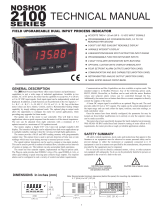
2
5. A/D CONVERTER: 16 bit resolution
A/D Conversion Rate: 6 readings/sec.
6. DISPLAY RESPONSE TIME: 500 msec min.
7. USER INPUT:
Software selectable pull-up (8.6 K) or pull-down resistor
(3.9 K) that determines active high or active low input logic.
Trigger levels: V
IL
= 1.0 V max; V
IH
= 2.4 V min; V
MAX
= 28 VDC
Response Time: 5 msec typ.; 50 msec debounce (activation and release)
8. COMMUNICATIONS:
Type: RS485 or RS232
Isolation To Sensor & User Input Commons: 500 Vrms for 1 min.
Working Voltage: 50 V. Not Isolated from all other commons.
Data: 7/8 bits
Parity: no, odd or even
Baud Rate: 300 to 38.4 K
Bus Address: Selectable 0 to 99, Max. 32 meters per line (RS485)
9. MEMORY: Nonvolatile E
2
PROM retains all programming parameters and
max/min values when power is removed.
10. OUTPUT:
Type: Single FORM-C relay
Isolation To Sensor & User Input Commons: 1400 Vrms for 1 min.
Working Voltage: 150 Vrms
Contact Rating: 5 amps @ 120/240 VAC or 28 VDC (resistive load), 1/8
H.P. @ 120 VAC (inductive load)
Life Expectancy: 100,000 minimum operations
Response Time:
Turn On Time: 4 msec max.
Turn Off Time: 4 msec max.
11. ENVIRONMENTAL CONDITIONS:
Operating temperature: 0 to 65 °C
Storage temperature: -40 to 70 °C
Operating and storage humidity: 0 to 85% max. RH (non-condensing)
Vibration According to IEC 68-2-6: Operational 5 to 150 Hz, in X, Y, Z
direction for 1.5 hours, 2 g’s (1 g relay).
Shock According to IEC 68-2-27: Operational 30 g’s (10 g relay), 11 msec
in 3 directions.
Altitude: Up to 2,000 meters
12. CONNECTIONS:Internal removable terminal blocks
Wire Strip Length: 0.4" (10 mm)
Wire Gage: 24-12 AWG copper wire, 90°C rated insulation only
Torque: 5.3 inch-lbs (0.6 N-m) max.
Cable Diameter: Outside diameter must be 0.181" (4.6 mm) to 0.312" (7.9
mm) to maintain NEMA 4 rating of cord grips.
13. CONSTRUCTION: Aluminum enclosure, and steel side panels with textured
black polyurethane paint for scratch and corrosion resistance protection. Meets
NEMA 4X/IP65 specifications. Installation Category II, Pollution Degree 2.
14. CERTIFICATIONS AND COMPLIANCES:
SAFETY
UL Listed, File # E137808, UL508, CSA C22.2 No. 14-M95
File # E179259, UL61010-1, CAN/CSA C22.2 No. 61010-1
LISTED by Und. Lab. Inc. to U.S. and Canadian safety standards
Type 4X Enclosure rating, UL50
IECEE CB Scheme Test Report #E179259-A3-CB-1
Issued by Underwriters Laboratories, Inc.
IEC 61010-1, EN 61010-1: Safety requirements for electrical equipment
for measurement, control, and laboratory use, Part 1.
IP65 Enclosure rating, IEC 529
ELECTROMAGNETIC COMPATIBILITY
Emissions and Immunity to EN 61326: Electrical Equipment for Measurement,
Control and Laboratory use.
Notes:
1. Criterion A: Normal operation within specified limits.
2. Criterion B: Temporary loss of performance from which the unit self-
recovers.
15. WEIGHT:
LD2A05XX - 4.5 lbs (2.04 kg)
LD4A05XX - 10.5 lbs (4.76 kg)
1.0 INSTALLING THE METER
Class AEN 55011Emissions
0.5 cycle
Criterion AEN 61000-4-11
Emissions:
Voltage dip/interruptions
3 V/rms
Criterion BEN 61000-4-6RF conducted interference
1 kV L-L,
Criterion AEN 61000-4-5Surge
1 kV signal
2 kV power
Criterion BEN 61000-4-4Fast transients (burst)
2 kV L&N-E power
10 V/m
Criterion BEN 61000-4-3Electromagnetic RF fields
8 kV air discharge
4 kV contact discharge
Criterion BEN 61000-4-2Electrostatic discharge
Immunity to Industrial Locations:
INPUT RANGE JUMPER
This jumper is used to select the proper input range. The input range selected
in programming must match the jumper setting. Select a range that is high
enough to accommodate the maximum signal input to avoid overloads. To
access the jumper, remove the side cover of the meter.
Warning: Exposed line voltage exists on the circuit boards.
Remove all power to the meter and load circuits before accessing
inside of the meter.
2.0 SETTING THE JUMPERS
RANGE SELECT
654231
TBC
20 V/200 V
200 MV/2 V
10 V
200 µA
200 MA
20 MA
2 MA
INSTALLATION
The meter meets NEMA 4X/IP65 requirements when properly installed.
INSTALLATION ENVIRONMENT
The unit should be installed in a location that does not exceed the operating
temperature. Placing the unit near devices that generate excessive heat should
be avoided. The unit should only be cleaned with a soft cloth and neutral soap
product. Do NOT use solvents.
Continuous exposure to direct sunlight may accelerate the aging process of
the front overlay. Do not use tools of any kind (screwdrivers, pens, pencils, etc.)
to operate the keypad of the unit.
MOUNTING INSTRUCTIONS
This display is designed to
be wall mounted or
suspended from a ceiling
truss or other suitable
structure capable of
supporting the LDA.
Caution should be
exercised when hanging
the display to provide for
the safety of personnel. If
hanging the LDA, run the
suspension cables (or chains)
through the mounting bracket
holes. For wall mounting use
#10-32 size bolts.
MOUNTING HOLE (.281")
MUST BE
CONNECTED TO
TERMINAL #3 (TBA)

















